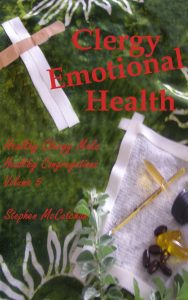This is excerpted from the soon to be published Clergy Emotional Health.
CAREGIVERS ARE HUMANS
Recently we have experienced two major kinds of disaster–Natural disasters like hurricanes and volcanoes and violent tragedy caused by humans. In each case, we have watched caregivers come forward to assist the victims of these experiences. These caregivers share their strengths, skills, resources, and compassion generously. Our humanity is affirmed by their behavior.
EMPATHY DRINKS IN PAIN
Often silently, these caregivers absorb the pain of the victims of these disasters and pay a heavy price. Both the caregivers and those who surround them need to be aware of the critical importance of paying attention to the caregiver’s need for self-care. Failure to do so can have long-lasting negative effects on their health and spiritual well-being. In the face of disaster, too often the caregivers avoid self-care because the plight of the victims is so devastating. We forget that even Jesus took time to withdraw from the needs of the crowds to attend to his own needs and that of his disciples.
THREE PHASES
Using the image derived from Moses leading the Israelites out of slavery, I want to suggest three phases that most caregivers will experience and suggest healthy ways they can attend to themselves during those times. I will call them the Red Sea, Wilderness, and Jordan Crossing phases.
RED SEA PHASE
Like Moses seeing the Egyptian army approaching and needing to respond by parting the sea, the Red Sea phase is the direct-action phase. Whether it is finding shelter, offering medical attention, and food during a natural disaster or offering a hug, a voice, and security in the face of violence, caregivers reach out to multiple victims. Without counting the costs, they expend themselves in any way that is possible.
The needs seem overwhelming and endless. It is important for the caregiver to pay attention to their own needs for rest, food, and companionship. We forget that even Jesus took time to withdraw from the needs of the crowds to attend to his own needs and that of his disciples. You will be a far more effective caregiver if you take the time to attend to your own health. Eating, sleeping, taking breaks, and engaging in conversation and community with non-victims can help rejuvenate you.
WILDERNESS EXPERIENCE
When the immediate disaster is over, caregivers enter what I call the wilderness experience. You will recall that once the most immediate threat was over and the people were in the wilderness, the grumbling and complaining began. In the first phase, while it is exhausting, there are direct immediate actions to be taken. In the wilderness phase, both the caregivers and the victims have the structure of a normal life shattered. People begin to experience disillusionment, promises not kept, outbursts of anger, feelings of betrayal, and a loss of hope. The caregiver has the burden of not having answers to these needs. They may even begin to question their own faith and entertain doubts about their calling.
Like Moses, the caregiver can be overwhelmed by the victim’s needs and the lack of clear answers. Though they have parallel feelings, they can feel guilty expressing their personal needs because the losses of the victims seem so obvious. This is a time for them to make use of prayer and Scripture and other ways of nurturing their spiritual resources. Physical exercise, massage, and meditation can help. Caregivers are particularly vulnerable to experience isolation and loneliness and must deliberately find companions and corporate experiences that build community. Caregivers who have experienced deep trauma need some trusted people to hear their stories as they search to reorient themselves. They also need to share some humor that can release them to a larger perspective.
JORDAN CROSSING
The third phase, which at times may not occur for several months, is what I call The Jordan crossing. This is when they begin to experience, however vaguely, the promise of new life. When the Israelites entered the Promised Land not everything was resolved. They still had many challenges to face, but they were captured by a vision that held promise for their future.
Caregivers often begin that experience in worship. Here they experience confession and forgiveness that restores them to life. Here they hear Scripture with fresh ears that recall the solid core of their faith but also the invitation to express their deepest pain to a loving God. Sharing lament, “My God, my God, why . . .” is a Christ-like step towards healing.
RECOGNIZING YOUR VULNERABILITY AND ATTENDING TO IT IS A FAITHFUL ACT.
